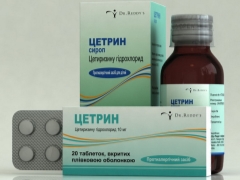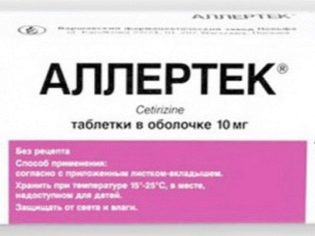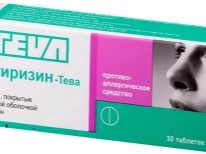Cephrine for children: instructions for use
"Cetrin" refers to the second generation of antihistamine drugs. Unlike the first generation antiallergic drugs, this drug has a longer therapeutic effect (up to 24 hours), does not provoke addiction (can be taken for a long time) and rarely causes side effects.
Such features allow you to write "Cetrin" not only adults, but also children suffering from allergies. To make the drug easier for the child or to prevent the appearance of an allergic reaction, you should know in what doses it can be given to children and when the use of "Cetrin" is not recommended.
Release form
"Cetrin" is produced in India and is presented in pharmacies in three dosage forms, suitable for children of different ages.
- Drops. This form of "Tsetrina" is prescribed to the smallest patients - from six months of age. It is a completely transparent liquid without any shade, poured into small glass bottles equipped with a dropper dispenser. In one bottle there is 10 or 20 ml of solution.
- Syrup. Such "Cetrin" can be given to children older than two years. He, too, is a clear liquid, in which there are no visible particles. Usually the syrup is clear, but it can be with a little yellowness. The smell of the drug fruit, taste - sweet. It is sold in dark glass bottles of 30 ml or 60 ml, and in order to easily dispense the medication, the manufacturer puts a measuring spoon in the box.
- Pills. This variant of "Cetrin" is allowed from 6 years of age. It has a dense white shell, and the shape of the tablets is convex on both sides, round. There is a risk on one side of the drug, due to which it is possible to divide the tablet into halves. Tablets placed in blisters of 10 pieces. Sold 20 or 30 tablets in one box.
Composition
The effect of any of the forms of "Cetrin" is provided by a substance called cetirizine. It is presented in the medicine in the form of dihydrochloride in the following dosages:
- 10 mg in one milliliter drops (approximately 0.5 mg in one drop);
- 1 mg in one milliliter of syrup;
- 10 mg per tablet.
The inactive components of the droplets are sodium hydrogen phosphate, propylene glycol, propyl and methyl parahydroxybenzoate, citric acid, glycerin, purified water and sucralose. The composition of the syrup includes fruit flavoring, benzoic acid, sorbitol, sucrose, water, edetate disodium, sodium citrate and glycerol. In addition to the active substance, magnesium stearate, lactose, corn starch and povidone K30 are added to the core of tablets, and talc, dimethicone, sorbic acid and some other substances are used for the shell of solid “Cetrin”.
Operating principle
As with other antihistamines, Tsetrin has anti-allergic, anti-exudative and antipruritic effects. It is caused by the competition of cetirizine with histamine - the compound binds to receptors sensitive to histamine, which blocks their availability and can both alleviate the course of the allergy and prevent its development.
The drug is especially effective at the onset of an allergic reaction, when histamine and other mediators only begin to be released from mast cells, but also act in the later stages, limiting the release of active substances and the movement of cells involved in the allergic reaction (basophils, neutrophils, etc.). Under the action of "Tsetrin" capillary permeability decreases, and the swelling of tissues and smooth muscle spasm passes.
The therapeutic effect after taking any form of the drug begins to develop in most patients within 20 minutes and lasts more than 24 hours. During the course of therapy, addiction to “Zetrin” does not develop, and after discontinuation of the drug its effect remains for some time (up to three days).
Removal of the drug occurs mainly in the urine, so kidney disease can affect this process.
Indications
"Cetrin" is in demand for various manifestations of allergy. The drug is prescribed for:
- pollinosis;
- atopic dermatitis and other allergic skin pathologies;
- angioedema;
- urticaria (including cold);
- severe itching with chickenpox;
- allergic rhinitis;
- conjunctivitis of an allergic nature;
- allergic cough;
- easy course of bronchial asthma.
Contraindications
When using "Tsetrin" in children, it is first of all important to remember the age limit for different forms of such a drug. Recall them:
- drops are contraindicated in babies of the first six months of life, and babies younger than one year are allowed to give them with caution (only as prescribed by a doctor and under his control);
- syrup is contraindicated in children under 2 years old;
- tablets should not be given to patients under 6 years old.
In addition, "Cetrin" is not prescribed, if the child has hypersensitivity to cetirizine or any of the inactive substances that are part of the medication. For serious diseases of the kidneys, which led to the dysfunction of this organ, the drug is given with caution (often the dosage is reduced).
Medical monitoring is also required when using “Tsetrin” in children with an increased risk of seizures, for example, in epilepsy.
Side effect
During treatment with “Cetrin”, the following side effects may appear:
- nausea;
- headache;
- dry mouth;
- rhinitis;
- fast fatiguability;
- drowsiness;
- dizziness;
- pharyngitis.
More rare negative reactions to taking “Cetrin” are diarrhea, paresthesias, nervous agitation, tachycardia, allergic rash, asthenia, urination disorders and other problems. If any of these symptoms occur, it is recommended to stop treatment and consult a doctor.
Application
Diet at the time of receiving "Tsetrina" does not affect, so you can give the medicine to the child before meals and after feedings. The drops are dissolved in a small amount of water, the syrup is given to the children undiluted, but it can be taken with water if required. The tablet is not chewed, but swallowed and washed down with about 200 ml of water.
According to the instructions for use, “Cetrin” in drops is administered in such dosages:
- babies aged 6-12 months only under the supervision of a physician - 5 drops once a day;
- babies 12-24 months - 5 drops to receive 1 or 2 times a day;
- patients 2-6 years old - 5 drops to the reception twice a day or 10 drops at once once every day;
- children over 6 years old - 10 drops once a day, but if necessary, the dosage is increased to 20 drops once.
“Cetrin” in syrup is discharged to children according to this scheme:
- if a child is from 2 to 6 years old (for example, 4 years old), then he is given 5 ml of syrup once a day or this amount of medicine is divided into two doses of 2.5 ml (5 mg daily dose);
- if a small patient is already six years old, he should take 10 ml of the drug once a day or drink 5 ml twice a day (daily dose is 10 mg).
Tablets "Tsetrin" for children 6 years and older are usually given one tablet once a day, but it can also be taken in half a tablet twice a day, that is, the daily dosage is 10 mg.
The duration of treatment with Cetrin is influenced by many factors, among which the most significant is the severity of the course of an allergic disease. For example, in acute allergies, the drug is usually prescribed for 10-14 days. If the symptoms disappear earlier, the use of "Cetrin" can be stopped as soon as the patient's condition has improved.
If the doctor prescribes the drug as a prophylactic, the course will be longer - not less than a month. Reception of “Tsetrin” for prophylaxis is continued as long as there is a risk of an allergic reaction, for example, if you are allergic to pollen, the medication should be given the entire period of flowering of trees, while there is a chance of contact with the allergen.
If the child is prone to allergic skin reactions (atopic diathesis), the drug can be administered in courses of up to 14 days several times a year. Such prophylactic administration reduces the incidence of true allergies. In case of bronchial asthma, the medication is also prescribed with non-durable courses (from 2 weeks to 20 days), adding “Cetrin” to the basic therapy of this disease.
Overdose
If a child accidentally drinks “Cetrin” in a large dose (more than 50 mg at once), it will lead to diarrhea, dizziness, itching, restless behavior, weakness, tremor, drowsiness, and other negative symptoms. In a situation where an overdose is detected immediately after taking the medicine, you should immediately induce vomiting or flush the stomach, and then give "Activated carbon».
There is no antidote to this medication, therefore, in case of poisoning with “Cetrin”, the doctor will prescribe symptomatic supportive treatment.
Interaction with other drugs
The instructions to "Cetrin" noted that this medicine can be used in combination with many other means, including macrolide antibiotics, diazepam, cimetidine, theophylline and other medicines. However, when prescribed with drugs that can inhibit the bone marrow, the hematotoxic effect of “Cetrin” will increase.
Terms of sale
Any form of the drug can be obtained without any problems in the pharmacy, since all the variants of Tsetrin are non-prescription medications. The average price of 20 tablets is 150 rubles, and 60 ml of syrup costs about 120 rubles.
Storage conditions
Having bought “Cetrin”, it should be hidden at home in a place where a small child will not find medicine. Storage temperature of the drug should not exceed +25 degrees Celsius. The shelf life for Tsetrina in drops is 3 years, and for syrup and tablet form - 2 years.
Reviews
The treatment with “Cetrin” is mostly positive, noting among the advantages of the drug a variety of its forms (you can find a suitable remedy for a child of any age), the need to take it only once a day and the absence of addiction. According to the parents, the side effects of such a drug are rarely provoked, and most of the children tolerate Cetrin well.
The benefits of drugs include its affordable cost. As for the minuses, some patients after taking “Tsetrin” still get drowsiness and other negative symptoms. Also, there are reviews that complain about the lack of a pronounced positive effect (the drug did not fit a particular child).
Analogs
In "Tsetrin" there are many drugs-analogues, which also include cetirizine and have the same healing properties. These include such drugs:
- Zyrtec;
- Zodak;
- "Parlazin";
- Cetirizine Hexal;
- Allertec;
- Cetirizine;
- Cetirizin-Teva;
- Cetirizine Sandoz;
- Cetirinax;
- Letizen.
Most of these drugs are coated tablets, but many of the drugs are liquid forms that are approved for use in the smallest patients. If it is required to replace “Cetrin” with an antihistamine medicine with another active ingredient, the doctor may prescribe one of these drugs:
- "Erius" is a syrup that contains desloratadine and is approved for children older than one year;
- "Fenistil" - containing dimetinden drops, which are given to children older than 1 month;
- «Suprastinex"- drops on the basis of levocetirizine, used from 2 years of age;
- «Claritin"- loratadine-based syrup permitted to children over 2 years old;
- «Tavegil"- tablets for children over 6 years old that contain clemastine.
On how to deal with allergies in children, see the following video.














































